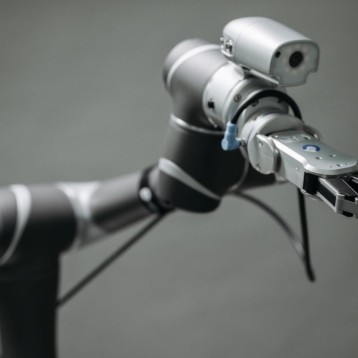The “AirJelly” is a remote radio-controlled airborne jellyfish with a central electric drive unit and an intelligent adaptive mechanism. Weighing slightly over 1.3 kilograms and measuring 2.20×1.35 meters, this machine consists of a helium-filled ballonet, which can be filled with a volume of 1.3 cubic meters of helium. One cubic meter of helium can support lifting approximately one kilogram, and therefore, the “AirJelly” is limited to a weight of no more than 1.3 kilograms.
AirJelly’s sole source of power are two rechargeable lithium-ion polymer accumulator batteries rated at 8 V and 400 mA. A connected central drive unit transmits the power to a bevel gear and then to eight spur gears, which power eight shafts that activate cranks – these, in turn, move the jellyfish’s eight tentacles. According to the inventors, the structure of the tentacles was derived from the functional anatomy of a fish’s fin. “It consists of two alternating tension and pressure flanks movably connected by ribs. If a flank is subjected to pressure, the geometrical structure automatically bends in the direction of the applied force. Together, the tentacles produce a peristaltic forward motion similar to that of their biological model”, explained Festo.
AirJelly’s motion in the air is controlled by weight displacement. A 55cm-long pendulum, which is set by two actuators, defines the system’s centre of mass by the direction of its motion, causing the airborne jellyfish to “swim” in a certain direction. The scientists say that by this forward motion, AirJelly can move in any spatial direction, making it the first indoor flight device with a peristaltic drive. “With this exhibit, Festo is demonstrating that a central electric drive unit in combination with an intelligent mechanism opens up fascinating opportunities in propulsion systems for lighter-than-air flight”, said the company.
The AirJelly is not the first project in which Festo has combined nature-inspired principles; some of the company’s most impressive projects include the “Airacuda”, a remote controlled pneumatically driven fish, and the “AirRay”, a remote-controlled ballonet filled with helium and constructed with a flapping-wing drive mechanism. The company has also created the “Airic’s Arm”, a mechanical arm, operated by fluidic artificial muscles.
More information on the AirJelly can be found here, and a video demonstrating the invention can be found here.










